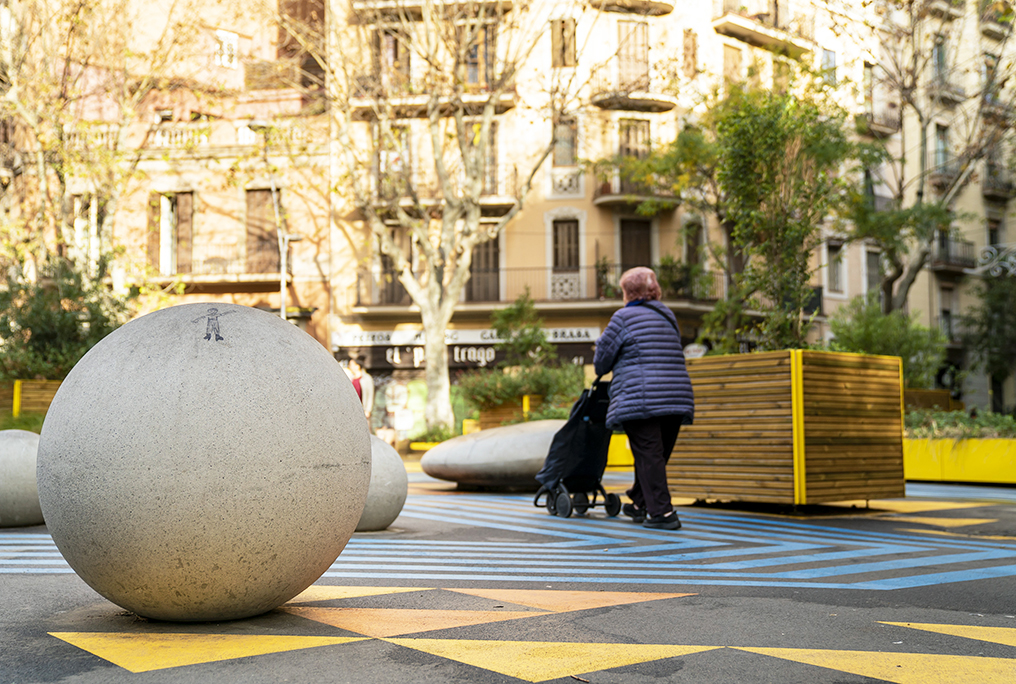 Our director Carmen Mendoza Arroyo speaks at a roundtable discussion ‘Superblocks – Towards a new Urban Model’
Our director Carmen Mendoza Arroyo speaks at a roundtable discussion ‘Superblocks – Towards a new Urban Model’
Public health has always been one of the major drivers of urban change. Climate change, air pollution and the current pandemic are key factors in the pursue of healthier and more sustainable cities. Paris created the 15-Minute-City. In Barcelona, the new urban model of the Superblocks has been introduced that aims to free up 70% of road space all over the city. But how do we transform public space to create equitable and collective spaces?
Our director Carmen Mendoza Arroyo took part in a recent roundtable discussion titled ‘Superblocks, Towards a new urban model – Public Space and Collective Space’ organised by the Architects’ Association of Catalonia (COAC). The debate aimed to investigate the potential of the Superblock model as multifunctional meeting and citizen spaces to provide opportunities for leisure, mobility, culture and to exercise democratic rights.
 The Superblock model: freeing up traffic areas for pedestrians
The Superblock model: freeing up traffic areas for pedestrians
Like most cities, Barcelona’s streets and roads are exclusively dedicated to mobility. The current system is therefore responsible for the main problems the city faces – a lack of space, high pollution, noise levels, traffic volumes and accidents. The Superblocks – cornerstone of the city’s Ecosystemic Urbanism Model – establishes a new traffic circulation model that integrates all modes of traffic and frees up the maximum amount of traffic area. One Superblock is made up of nine city blocks with a total size of around 400×400; internal traffic is reduced to one lane and transit traffic diverted to the perimeter roads. Currently, two pilot projects have been completed. However, the Superblocks have also drawn some criticism. The Barcelona Laboratory for Urban Environmental Justice and Sustainability has repeatedly highlighted the risk of a possible Greenwashing effect and gentrification. They consider the awareness of social inequity and gentrification, and the inclusion of citizens in the decision-making processes as crucial aspects for the success of the model.
A number of different local architects and academics participated in the roundtable discussion that centred around the question what steps the architecture profession should take towards a new urban model and how public space can be transformed to be more citizen-centred. It was acknowledged that architects should make more efforts to talk to citizens and research how people use and move through the city – especially during the pandemic. Furthermore, the social dimension of public space, often pushed to the background, was recognised as a vital component. Public space therefore needs to be a speculative space, a laboratory and an open process rather than follow an urban model. It should be flexible and capable of accommodating different ways of city-making, citizen participation and uses. With the implementation of the Superblocks, public space can be made available and a framework given to integrate these aspects.
 Speaking of the importance of everyday life and the multidimensional nature of power in the city, Carmen Mendoza Arroyo pointed out: “Public space is a political space and a social space. It is a space to create identities and to build communities. The question is how can we adapt public spaces to the needs of the citizens? In my opinion, this needs to be done through developing social sustainability, which can only be achieved through citizen participation. This process can be broken down into three basic steps: information, consent and co-production. If the social and participatory aspects play a key role in the production and transformation of public spaces, they have the potential to generate systemic change towards a new urban model. To create truly inclusive spaces for all citizens, we need to identify the users and their necessities and commit to the social function of our cities.”
Speaking of the importance of everyday life and the multidimensional nature of power in the city, Carmen Mendoza Arroyo pointed out: “Public space is a political space and a social space. It is a space to create identities and to build communities. The question is how can we adapt public spaces to the needs of the citizens? In my opinion, this needs to be done through developing social sustainability, which can only be achieved through citizen participation. This process can be broken down into three basic steps: information, consent and co-production. If the social and participatory aspects play a key role in the production and transformation of public spaces, they have the potential to generate systemic change towards a new urban model. To create truly inclusive spaces for all citizens, we need to identify the users and their necessities and commit to the social function of our cities.”
Images: Superblock Sant Antoni, Ajuntament de Barcelona, Creative Commons Licensed
Illustration: Agència d’Ecologia Urban de Barcelona
Watch the video of the discussion below (in Catalan):

